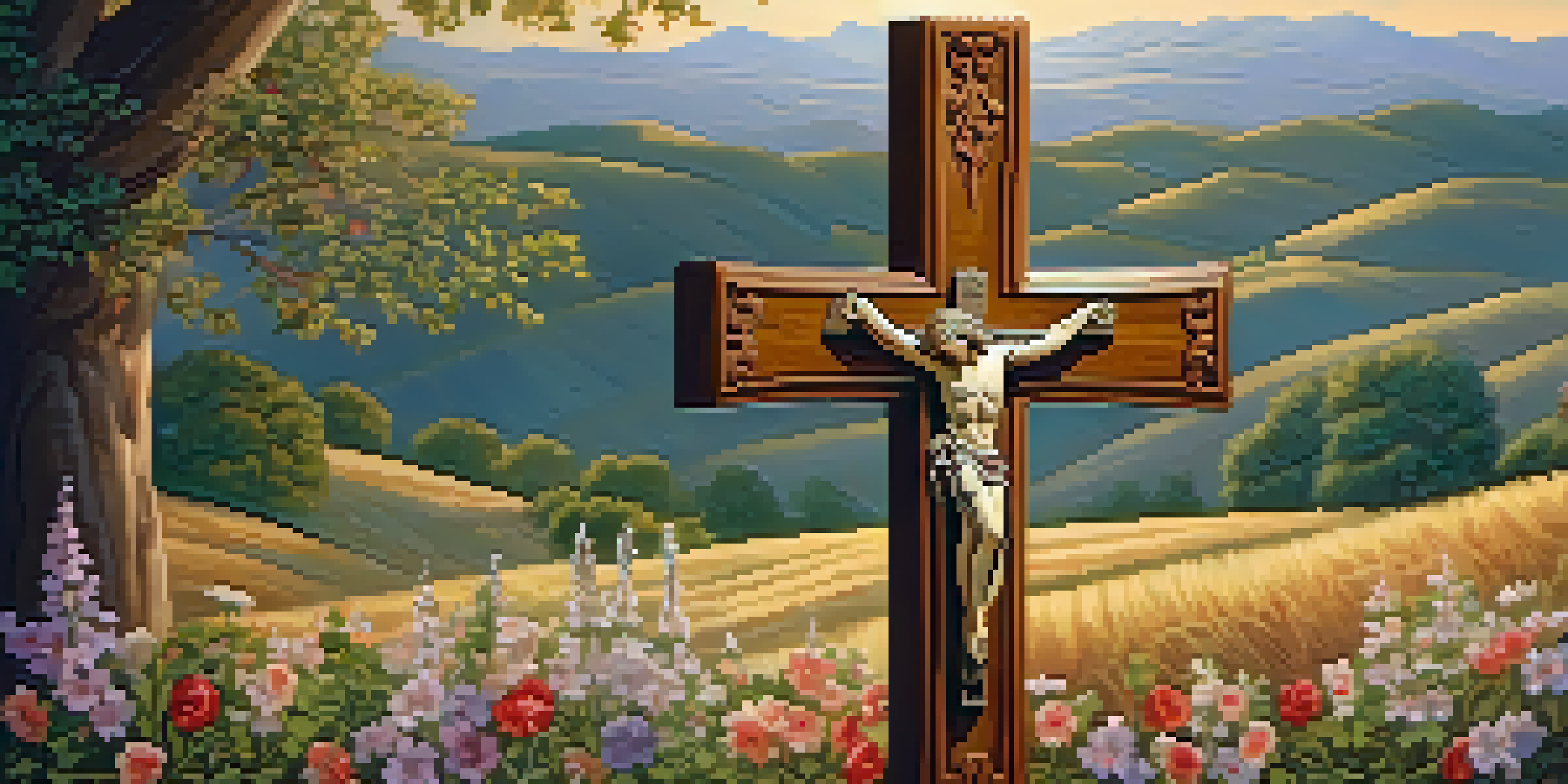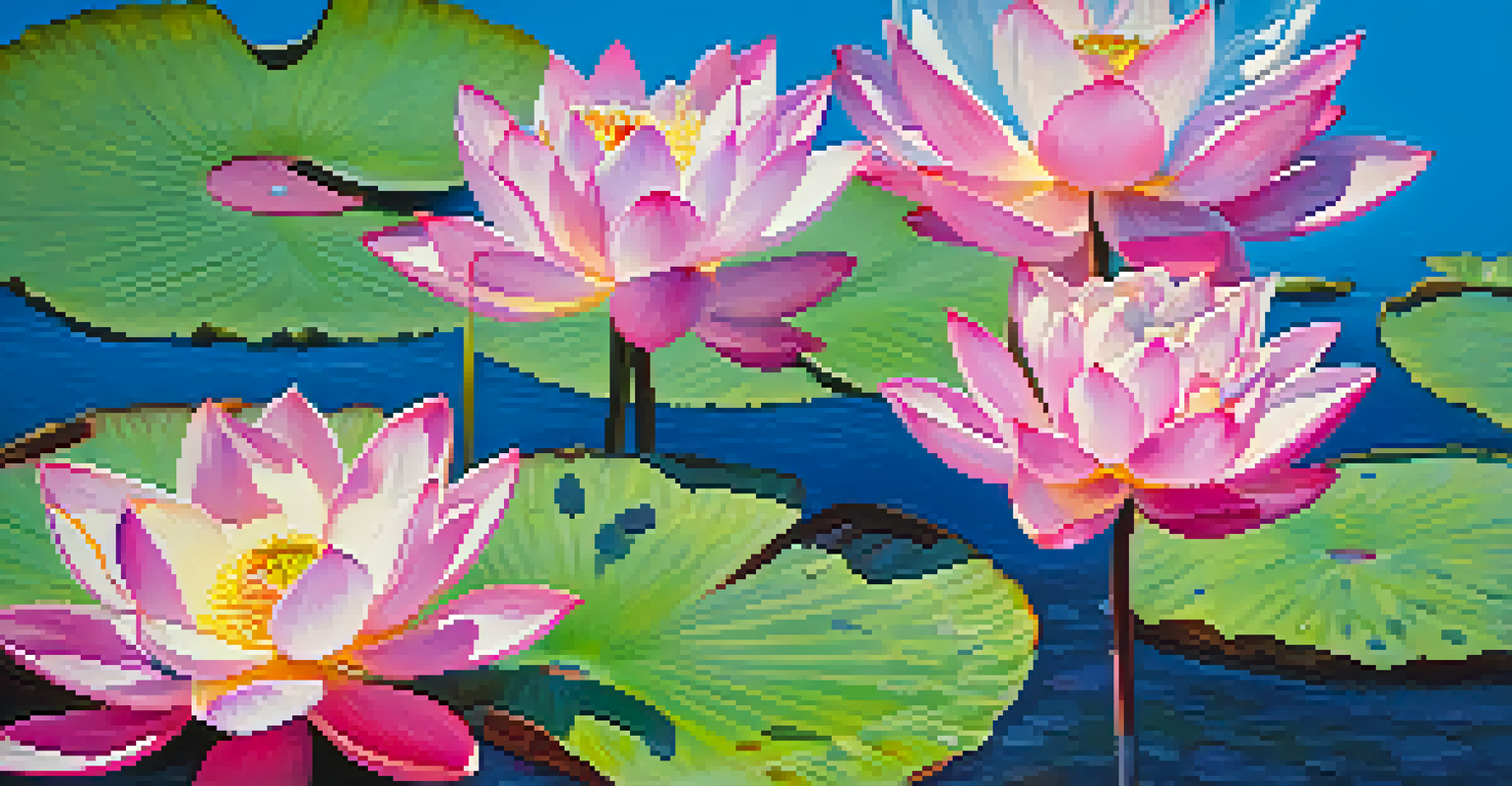Symbolic Meanings Behind Common Carvings in Religious Art

The Cross: A Universal Symbol of Faith and Sacrifice
The cross is perhaps the most recognizable symbol in Christian art, representing the sacrifice of Jesus Christ. It embodies themes of redemption and hope, often reminding believers of the promise of eternal life. Carvings of the cross can vary in design, from simple wooden representations to ornate gold ones, each telling a unique story of faith. Beyond Christianity, the cross has also appeared in various cultures, symbolizing different concepts such as balance and connection.
The cross is a reminder of the love of Christ, a symbol of hope that transcends time and culture.
In many religious artworks, the cross is depicted with additional symbols like flowers or rays of light, enhancing its significance. For instance, the inclusion of the sun or light often signifies divine presence or enlightenment. This interplay of symbols invites viewers to reflect on deeper meanings, connecting them to centuries of spiritual tradition. Such carvings not only beautify sacred spaces but also serve as teaching tools for the faithful.
Moreover, the cross's depiction in art can evoke personal interpretations, making it a powerful element in individual spirituality. People may find solace and strength through its imagery, drawing on its historical and theological roots. This personal connection reinforces the cross as a symbol that transcends mere representation, becoming a source of inspiration and contemplation for many.
Lotus Flower: Purity and Spiritual Awakening
The lotus flower is a prominent symbol in various religions, particularly in Buddhism and Hinduism, representing purity and spiritual awakening. This flower grows in muddy waters yet rises above to bloom in pristine beauty, symbolizing the journey of the soul from ignorance to enlightenment. Carvings of the lotus can often be found in temple art, serving as a reminder of perseverance and the potential for personal growth amidst challenges.

In Buddhist art, the lotus is frequently depicted as a throne for deities, emphasizing their divine nature and purity. This representation reinforces the idea that enlightenment can be achieved despite worldly struggles. The layers of a lotus also reflect the stages of spiritual development, with each petal symbolizing a step towards higher consciousness, inviting viewers to contemplate their own spiritual journeys.
Symbols Reflect Spiritual Journeys
Religious symbols like the cross, lotus, and tree of life invite personal reflection on faith, growth, and interconnectedness.
The lotus flower's significance extends beyond its religious connotations; it also embodies cultural values of beauty, resilience, and transformation. As such, it resonates with individuals from various backgrounds, making it a beloved symbol in art and design. Through its intricate carvings, the lotus inspires hope and encourages a deeper understanding of personal and collective growth.
The Tree of Life: Connection and Interconnectedness
The Tree of Life is a powerful symbol found in many religious traditions, representing the interconnectedness of all living things. Often depicted with expansive branches and deep roots, it embodies the idea of growth, strength, and the cycles of life. In various cultures, this motif illustrates the relationship between humanity, nature, and the divine, reminding us of our place in the universe.
Just as the lotus rises from the mud, so too can we rise from our challenges to bloom in beauty.
In Christian art, the Tree of Life is sometimes associated with the Garden of Eden, symbolizing eternal life and divine wisdom. Its carvings can be intricate, featuring fruits and flowers that signify the richness of spiritual blessings. This imagery invites viewers to reflect on their own spiritual heritage and the importance of nurturing their connections with others and the environment.
Additionally, the Tree of Life serves as a reminder of the importance of community and family bonds. Just as a tree relies on its roots to grow, individuals can thrive when they are grounded in supportive relationships. Through its depiction in religious art, the Tree of Life encourages us to appreciate our interconnectedness and the shared journey of growth and discovery.
The Serpent: Transformation and Duality
The serpent is a multifaceted symbol in religious art, often representing both transformation and duality. In many traditions, the serpent is viewed as a creature of wisdom, shedding its skin to signify rebirth and renewal. This aspect of the serpent highlights the potential for personal change and growth, encouraging individuals to embrace their transformative journeys.
Conversely, the serpent can also embody temptation and danger, as seen in the biblical story of Adam and Eve. This duality invites viewers to reflect on the complexities of human nature and the choices they face. Carvings of serpents in religious art often depict this tension, reminding us that transformation can arise from both light and dark experiences.
Art Enhances Spiritual Understanding
Intricate carvings in religious art serve as both aesthetic beauty and tools for deeper contemplation of spiritual beliefs.
Ultimately, the serpent's presence in religious art serves as a powerful metaphor for life’s challenges and the lessons learned through them. By confronting our fears and embracing change, we can emerge stronger and wiser. The rich symbolism of the serpent encourages introspection and a deeper understanding of the human experience.
The Dove: Peace and Divine Presence
The dove is universally recognized as a symbol of peace and purity, often depicted in religious art to signify the Holy Spirit. This gentle bird conveys messages of hope, love, and reconciliation, reminding us of the importance of harmony in our lives. Carvings of doves can be found in various sacred spaces, serving as visual representations of divine presence and comfort.
In Christianity, the dove is famously associated with the story of Jesus' baptism, where it descends from heaven to signify God's approval. This association reinforces the dove's role as a messenger of divine grace and peace, inviting believers to seek inner tranquility amidst life's chaos. The soft, serene imagery of doves encourages viewers to reflect on their own relationships and the importance of fostering peace in their communities.
Moreover, the symbolism of the dove extends beyond religious contexts, resonating with universal themes of love and unity. Its presence in art inspires individuals to embrace compassion and understanding, promoting a sense of belonging and togetherness. Through its intricate carvings, the dove serves as a gentle reminder of our shared humanity and the power of peace.
The Fish: Abundance and Christ's Message
The fish is an ancient symbol that holds significant meaning in Christianity, representing abundance and the message of Christ. Often depicted in religious art, the fish symbolizes the followers of Jesus, who were primarily fishermen. Its simple yet profound representation serves as a reminder of the nourishing qualities of faith and the importance of sharing abundance with others.
Carvings of fish can also be seen as a nod to the miracle of the loaves and fishes, where Jesus fed thousands with a small amount of food. This story emphasizes the theme of generosity and the idea that even the smallest acts of kindness can have a profound impact. The fish serves as a powerful reminder of the call to serve and uplift others in our communities.
Universal Themes in Religious Symbols
Many symbols, such as the dove and fish, resonate across cultures, embodying concepts like peace, abundance, and community.
Moreover, the fish symbol has historical roots in early Christian art, where it was used as a secret sign among believers. This aspect highlights the resilience of faith in times of adversity and the importance of community support. Through its depiction in religious art, the fish continues to inspire and encourage a spirit of generosity and connection.
The Mandala: Unity and Cosmic Order
Mandala designs are intricate patterns that symbolize unity and the cosmic order of the universe. Commonly found in Buddhist and Hindu art, mandalas serve as spiritual tools for meditation and contemplation. Their circular shapes represent wholeness and the idea that everything is interconnected, inviting viewers to reflect on their place within the greater cosmos.
In religious contexts, mandalas often depict deities, sacred symbols, and natural elements, creating a visual representation of the divine. This complexity encourages deeper exploration of spiritual beliefs and personal philosophies. The process of creating or meditating on a mandala can also promote mindfulness, helping individuals connect with their inner selves and the world around them.

Beyond their spiritual significance, mandalas have gained popularity in various art forms, symbolizing balance and harmony in life. Their captivating designs inspire creativity and self-expression, making them a beloved motif in both religious and secular art. Through the rich symbolism of mandalas, we are reminded of the beauty and interconnectedness of all existence.